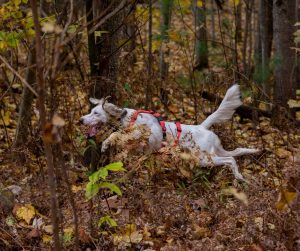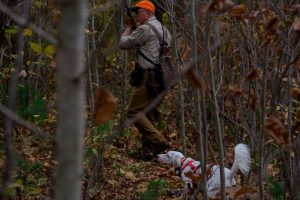When Dr. Kirk Brumels looks at his Llewellin setter, Dixie, he not only sees a beloved family member, he also sees an athlete. The kinesiology professor, athletic trainer and avid upland bird hunter can’t help but recognize both bonds with his dog. And because he does, Brumels’ vocation met his avocation when he recently authored an article about knee ligament tears in hunting dogs for Retriever Journal, a periodical dedicated to the hunting relationship between sporting dogs and their human partners.

In his story, “Cruciate Injuries,” Brumels apprises readers about the reasons why hunting dogs tear their cranial cruciate ligaments (CCL) — the human equivalent is the anterior cruciate ligament (ACL) — and how those injuries can be prevented. Not surprisingly, dogs tear their CCLs, and get the tear corrected, the same way humans do: Cruciate tears come from strenuous and abrupt changes in direction of motion and surgery is the only way to repair them.
Brumels’ interest in the subject was born from hearing other hunters’ concerns about their dogs’ potential or real injuries and from watching his lithe and sinewy Dixie take off through the woods with great speed and physicality, sometimes with unfettered abandon. Having once been an athletic trainer for the New England Patriots as well as the former head athletic trainer for Hope sports, Brumels knows that when he sees an athlete in action, the prevention of injury is really the best treatment of injury. This is true of an athletic dog as any athletic human.

“Once I started getting into upland bird hunting (for grouse and woodcock) and in my understanding that these dogs and other sporting dogs are basically like high-profile athletes, I wanted to research and share more about helping other owners avoid CCL tears with their dogs,” says Brumels, professor of kinesiology and chairperson of the department. “You get a dog and you spend a ton of time and money training her and the nightmare is she gets an CCL tear. Then she can’t do what she’s loves to do, was bred to do — which is run in the woods and hunt. And of course, then you can’t do what you love to do, too — which is hunt with your dog.”
If a dog were to stand on its hind legs, its knees are the large, rounded joints slightly angled toward the ground. It is at this joint where the canine CCL is located.
To help understand where a dog’s CCL actually is, consider that the front legs of a dog are like human arms — with its shoulders, elbows, and wrists — and its hind legs are like human legs — with its hips, knees and ankles. “Dog bones are like our bones and their bone names are similar to ours, too, except all four of a dog’s limbs are oriented toward the ground,” informs Brumels, who primarily teaches human anatomy at Hope.
So, if a dog were to stand on its hind legs, its knees are the large, rounded joints slightly angled toward the ground. It is at this joint where the canine CCL is located.
With his expertise in human anatomy and sports medicine, Brumels transferred his knowledge of both astutely to the dog world, with help from other experts who spoke to canine kinetics and nutrition in his article. Veterinarians and dog trainers informed Brumels’ own knowledge and writing, and the end product was a story that hunting dog owners should be keen to heed.
But there are issues with a warm-up protocol: You can’t really tell a dog to go take a few easy laps through the woods before starting to seriously hunt and often the excited dog just want to get going.
Though one can never completely prevent CCL tears in dogs — and ACL tears in humans for that matter — Brumels advocates certain steps to intervene in the probability of them. Carefully monitoring protein intake is one way. Another is to actually warm up and cool down a dog before it goes out and comes back from a hunt, just as any human athlete would before and after vigorous physical exercise.
But there are issues with that protocol: You can’t really tell a dog to go take a few easy laps through the woods before starting to seriously hunt and often the excited dog just wants to get going. So Brumels starts off with Dixie doing short time and distance increments.

“We start with a number of breaks right at the beginning,” Brumels says. “We’ll go out for a couple minutes then I call her back and have her stay for a bit, give her some water. I’m getting her warmed up in short exercise bursts.
“But I have to be honest that we don’t always warm-up, and I know better,” he confesses.
Yet, Brumels vows he’ll get better at it after writing his article because avoiding a CCL injury with Dixie means avoiding the adage, “a hunting dog becomes a house dog,” after a catastrophic injury. After all, the joy of the hunt is in them both.

